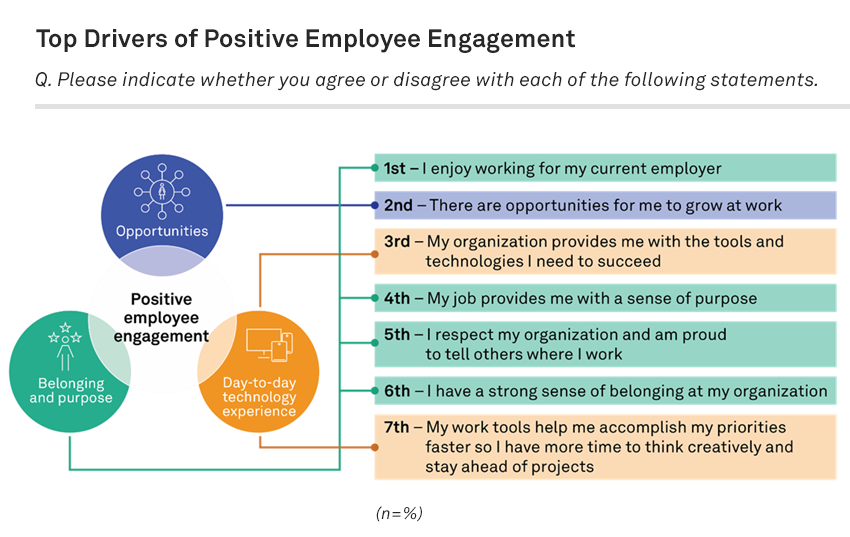
The role that productivity software and work technologies play in defining the employee experience has evolved in recent years as the shift to hybrid and remote work models magnified the friction points inherent in legacy tools. This increasingly digital employee experience has also heightened the impact these tools have on an organization’s ability to attract talent, keep them engaged and retain them. As this continues, new levels of collaboration will be forced on once-separate business units and buying cycles, and the market will likely respond to meet these emerging needs.
The Take
As the employee experience grows increasingly digital (and in some cases wholly digital), the impact of productivity software and work tools will likely be felt to a much stronger degree. And that effect could be felt across the employee lifecycle, from efforts in attracting and recruiting talent to employee engagement and retention. Because of this, HR could work more closely with IT in buying cycles and to determine what tools will improve the employee experience rather than hinder it — and we expect the collaboration to begin around tools identified in our field research as having the biggest impact on day-to-day work. Beyond this, however, we have already begun to see the market respond as tools previously known only for providing value and visibility to IT are now looking to define their impact on employee engagement and vice versa.
Recruitment and onboarding
In the post-COVID era and the wake of the Great Resignation, there is no denying that job candidates have specific expectations for work flexibility and compensation. And while both of those are near the top of the list for recruitment challenges faced by managers, demands for modern technology outstrips both of those. When asked about the top recruitment challenges faced by their organization, team manager respondents to the 451 Research’s Workforce Productivity & Collaboration, Employee Lifecycle & HR 2023 survey listed “candidates expect software or tools we haven’t adopted” as the top recruitment challenge (52%) they face. To put that into context, the next-highest response was expectation of flexible work (42%) and then compensation expectations being too high (40%).
From this data we see that legacy technology investments or poor tooling choices limit recruitment opportunities. If organizations can overcome that hurdle, however, the pervasiveness of technology friction then could muddy the onboarding process as well.
Roughly 34% of non-HR respondents surveyed in that Employee Lifecycle & HR survey said it took them six months or longer to add value at work. When asked why they believe it took that long, the top response (49%) was a lack of proper technologies and tools needed to do my job.
Engagement and retention
The problem with technology friction, as mentioned earlier, is that it is pervasive. Nearly every day of our working lives are touched by it, and even if it can be overlooked in the hiring process, it will eventually affect the level of engagement an employee feels with their work. We recently performed a regression analysis on data from our Workforce Productivity & Collaboration, Employee Engagement 2022 survey to determine the top drivers of positive employee engagement. From the more than 40 different variables included in the analysis, the seven shown below (marked in order) are most likely to improve employee engagement.

As we can see from the above figure, having the right tools and technologies for work success drive positive engagement. Beyond just the right tools, however, one can infer from the seventh driver that technologies like intelligence and automation are also part of the equation for driving positive employee engagement. The current state of these technologies, from an engagement perspective, is not great.
According to that same Employee Engagement survey, only 45% of respondents believe the tools they use allow them to be very productive in their daily work, and only 45% believe the tools they use allow them to be as productive when working from a mobile or remote environment as they are at their desk.
This matters because pervasive tooling friction and legacy tech, when left unchecked, can lessen engagement. And that limited engagement, when left unchecked, leads to attrition. In our Employee Engagement survey, there is a clear line of sight from technology challenges to losing an employee. When asked how likely they would be to take a new job when the only way it differed from their current job was in better availability of devices, applications and other productivity tools, roughly 24% of respondents said they would be somewhat or very likely to take it. That is nearly a quarter of employee attrition that could possibly be solved (to some degree) by investing in modern work tools.
Where to start
A large part of supporting this change is that HR and IT will need to work more closely together, which has already begun. When asked which business function they collaborate with most frequently, HR respondents to our Employee Lifecycle & HR survey said IT. And, second only to HR (57%), those same respondents listed IT (49%) as the department that is directly involved in or leads their organization’s employee experience strategy. The next closest response was Finance at 27%.
HR also sees this as part of its future of work strategy. In that same survey we asked HR respondents what their priorities were for supporting their organization and equipping their employees for the future of work and almost half (49%) said a deeper interest and supporting and maintaining employee productivity and collaboration.
In terms of “boots on the ground” technology investments, it is best to focus on the low-hanging fruit — the technologies that employees most associate with their day-to-day productivity. According to data from 451 Research’s Workforce Productivity & Collaboration: Work Execution Goals & Challenges 2023 survey, the top five tools that contribute most to productivity at work include the following:
- All-in-one suite for spreadsheets, word processors, forms, slides, etc. (e.g., Microsoft Corp.’s Office 365, Google’s GSuite, Zoho Workplace) — 48%
- Collaboration/communication tools (e.g., Zoom, Slack, Google Meet, WhatsApp, WeChat) — 41%
- File sharing or content management tool to share and manage documents (e.g., SharePoint, Dropbox, Box) — 40%
- Business “systems of record” such as CRM, ERP or HCM (e.g., Salesforce, Workday, Netsuite ERP) — 22%
- Project and work management tools (e.g., Asana, JIRA, Planview, Smartsheet, Trello) — 20%
These tools represent a good starting point for inroads to productivity improvements. If you are seeking to understand why these tools are not working, or are in a buying cycle for new tools and want to address key pain points, it is also a good idea to understand what problems are plaguing your users. According to that same survey, the top obstacles to success in applications and productivity tools are as follows:
- No one application can do everything we need, too many applications are necessary — 27%
- There is not enough automation; the same basic tasks have to be repeated — 23%
- Information is siloed in different applications, making it difficult to search, access and use — 22%
- Applications do not integrate with one another — 21%
- It is difficult to collaborate effectively across applications — 16%
With this in mind, we may see increased interest in broad product portfolio suites or those with good integration opportunities and that prioritize workflow automation. Additionally, this is a go-to-market opportunity for vendors with products that can unify content or datasets and make it easier to work across teams.
Market impact
Vendors in the market have already noticed the value of connecting their tools to employee engagement. Digital adoption platform vendors like WalkMe, Whatfix and Pendo have been promoting features that help identify workflow friction points for some time. Now they are also offering analytics tools to help customers identify which features of a given internal tool, for example, are most easily adopted or drive the most work execution. These features are often framed with driving employee engagement as the outcome.
On the flip side, IT-centric observability and IT asset management vendors like Scalable Software, Riverbed, Nexthink and others have all shifted their end user experience management toward digital experience management, whereby they seek to monitor user behavior to provide insights on employee engagement and productivity improvement areas, among other things.
The rise of the employee experience platform market is another unique opportunity to address the connection of work tools to employee engagement, as vendors like Microsoft (with Viva) can work to bridge the gap between how these tools are used and what that means in the context of the broader employee experience strategy.
Want insights on workforce productivity and collaboration trends delivered to your inbox? Join the 451 Alliance.

